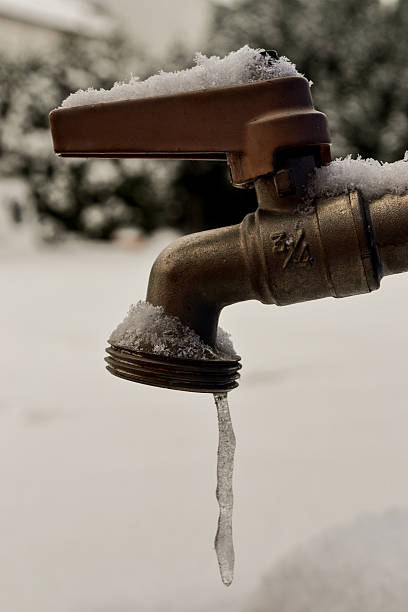We've noticed this post relating to How to Prevent Your Pipes From Freezing listed below on the internet and decided it made sense to write about it with you in this article.

Winter can ruin your pipes, specifically by freezing pipes. Here's how to prevent it from taking place and what to do if it does.
Introduction
As temperatures drop, the risk of icy pipes increases, possibly bring about expensive fixings and water damages. Comprehending just how to prevent frozen pipelines is essential for house owners in cool climates.
Recognizing Frozen Pipes
What causes pipes to freeze?
Pipelines ice up when exposed to temperatures below 32 ° F (0 ° C) for prolonged periods. As water inside the pipelines ices up, it broadens, putting pressure on the pipe wall surfaces and potentially triggering them to rupture.
Dangers and damages
Frozen pipelines can lead to water system disruptions, residential property damage, and costly fixings. Burst pipes can flood homes and trigger considerable architectural damage.
Indications of Frozen Pipeline
Identifying frozen pipelines early can stop them from breaking.
Just how to identify frozen pipelines
Search for decreased water circulation from faucets, uncommon odors or sounds from pipes, and noticeable frost on exposed pipelines.
Prevention Tips
Insulating at risk pipes
Cover pipelines in insulation sleeves or use warm tape to protect them from freezing temperatures. Concentrate on pipes in unheated or outside locations of the home.
Heating techniques
Maintain indoor rooms properly warmed, especially areas with pipes. Open up closet doors to allow warm air to distribute around pipes under sinks.
Shielding Exterior Pipes
Yard hoses and exterior taps
Detach and drain pipes garden hoses prior to wintertime. Set up frost-proof spigots or cover outdoor taps with insulated caps.
What to Do If Your Pipes Freeze
Immediate actions to take
If you presume frozen pipelines, maintain faucets available to alleviate stress as the ice melts. Utilize a hairdryer or towels soaked in hot water to thaw pipes slowly.
Long-Term Solutions
Structural modifications
Think about rerouting pipes far from outside walls or unheated areas. Add additional insulation to attics, cellars, and crawl spaces.
Updating insulation
Invest in high-grade insulation for pipelines, attics, and wall surfaces. Appropriate insulation aids keep regular temperatures and minimizes the threat of icy pipes.
Conclusion
Avoiding icy pipes needs aggressive measures and quick responses. By understanding the reasons, indications, and preventive measures, home owners can safeguard their plumbing throughout winter.
6 Proven Ways to Prevent Frozen Pipes and Protect Your Home
Disconnect and Drain Garden Hoses
Before winter arrives, start by disconnecting your garden hoses and draining any remaining water. Close the shut-off valves that supply outdoor hose bibs and leave the outdoor faucet open to allow any residual water to drain. For extra protection, consider using faucet covers throughout the colder months. It’s also important to drain water from any sprinkler supply lines following the manufacturer’s directions.
Insulate Exposed Pipes
Insulating your pipes is an effective way to prevent freezing. Pipe insulation is readily available at home improvement stores and is relatively inexpensive. Pay close attention to pipes in unheated areas such as the attic, basement, crawl spaces, or garage. Apply foam insulation generously to create a buffer against the cold. You can also wrap your pipes in heat tape or thermostat-controlled heat cables for added warmth.
Seal Air Leaks
Inspect your home for any cracks or openings that could let in cold air. Seal any holes around the piping in interior or exterior walls, as well as the sill plates where your home rests on its foundation. Additionally, make sure to keep your garage door closed unless you’re entering or exiting. Leaving it open creates a significant air leak that can lead to frozen pipes.
Allow Warm Air Circulation
During cold snaps, it’s essential to allow warm air to circulate evenly throughout your home. Leave interior doors ajar to promote better airflow. Open kitchen and bathroom cabinets to help distribute heat consistently around the rooms. If you have small children or pets, be sure to remove any household chemicals or potentially harmful cleaners from open cabinets for safety.
Let Faucets Drip
A small trickle of water can make a big difference in preventing ice formation inside your pipes. When temperatures drop significantly, start a drip of water from all faucets served by exposed pipes. This continuous flow helps prevent the water from freezing. Additionally, running a few faucets slightly can relieve pressure inside the pipes, reducing the chances of a rupture if the water inside does freeze.
https://choateshvac.com/6-proven-ways-to-prevent-frozen-pipes-and-protect-your-home/

We had been brought to that write-up on How To Avoid Freezing Pipes through someone on another site. Are you aware of somebody who is sincerely interested in the topic? Be sure promote it. Thanks so much for going through it.
See Availability